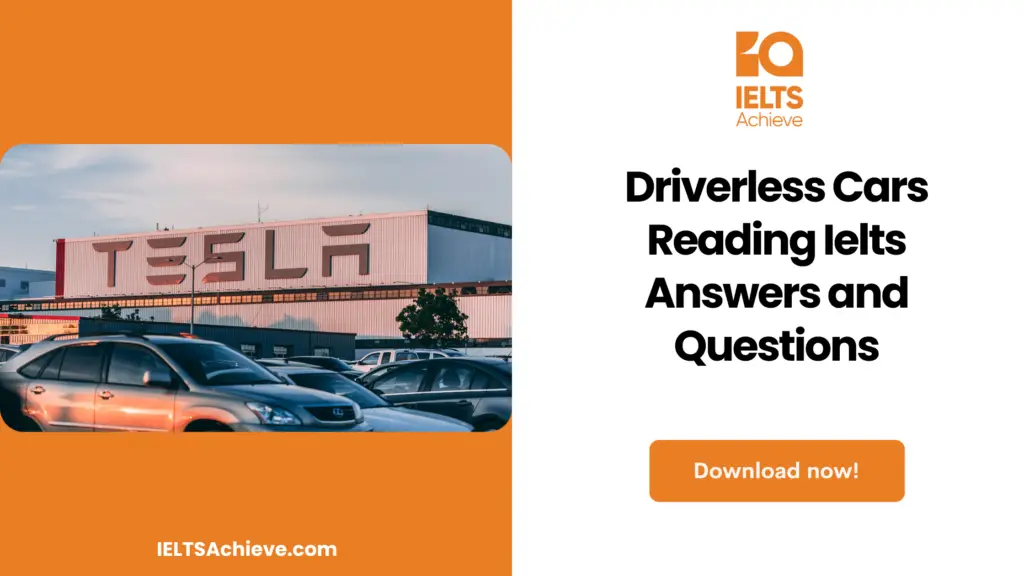The Blog post contains the following IELTS Reading Questions:
- IELTS Reading Locating Information
- IELTS Reading True/False/Not Given
- IELTS Reading Summary Completion
Stay informed and prepared for success – Explore our comprehensive Reading Test Info page to get valuable insights, exam format details, and expert tips for mastering the IELTS Reading section.
IELTS Reading passage 3 – Driverless Cars

Driverless Cars
The automotive industry is very used to adapting to automating manufacturing. From the 1970s the implementation of robotic car manufacture brought significant cost savings and improvements in the reliability and flexibility of mass production of vehicles. There is a new challenge to vehicle production on the horizon again and it comes from automation. But, this time it has nothing to do with the process of manufacturing, but with the vehicles themselves.
Vehicle automation research is not new. For more than 50 years, vehicles with limited self-driving capabilities have been around, which contributed significantly towards driver assistance systems. Progress in this field has quickly gathered pace since Google announced that it had been trialling self-driving cars on the streets of California in 2010.
Technology is advancing so fast due to many reasons. The biggest reason is safety. UK’s Transport Research Laboratory’s Research has shown that more than 90% of road collisions occur due to human error, and it is the biggest cause of road accidents. Automating driving may help to reduce the occurrence of this.
Another reason is to reduce the time people use for driving and make use of it for other purposes. It may be possible to socialise, be productive or relax if the vehicle can do some or all of the driving, while automation systems have all the responsibility for your safety. Those who are old or disabled may be able to travel alone if the vehicle can do the driving.
We can look at the wider implications for transport and society apart from these direct benefits, and how manufacturing processes might need to change as a result. At present, the average car spends its life parked for more than 90% of its life. Initiatives for car-sharing become more possible through automation, especially in cities with more demand for vehicles. Mobility demand can be met by far fewer vehicles if a significant proportion of the population chooses to use shared automated vehicles.
The Massachusetts Institute of Technology investigated automated mobility in Singapore, and found that less than 30% of the vehicles used presently would be needed if automated car-sharing could be fully implemented. In that case, it can mean that we may need to produce far lesser vehicles to meet the demand. The number of trips being taken may increase, because empty vehicles would have to be moved from one customer to the next.
Modelling work at the University of Michigan Transportation Research Institute indicates that automated vehicles might reduce ownership of vehicles by 43%, but as a result the average annual mileage of vehicles doubles. As a result, the vehicles would be used more frequently and will require replacement sooner. Due to this fast turnover the vehicle production may not necessarily decrease.
Automation may bring some other modifications in the manufacture of vehicles. If we move to a model where consumers don’t own any vehicles but will get access to different vehicles through a mobility provider, drivers will choose to select the vehicle that best suits their needs for a particular journey, rather than compromising on all their requirements.
Since, most of the seats in most cars are unoccupied most of the time, it can increase the development of smaller and efficient vehicles that match the needs of individuals. For going on exceptional journeys like a family trip or to help children move to a university specialised vehicles may be made available.
We should overcome many obstacles before delivering automated vehicles to our roads. These include the technical difficulties in making sure that the vehicle are reliable in traffic, different climate, and multiple road situations it might experience; the regulatory challenges in understanding how liability and enforcement might need to change when drivers are not needed; and the societal changes that is to be brought in communities to accept and trust automated vehicles as being a valuable part of the mobility landscape.
There is no doubt that many challenges need to be taken care of but, through targeted and robust research, these problems can be solved in the next 10 years. In the coming years mobility will change in many ways and will be associated with so many other technological developments, such as telepresence and virtual reality, which is difficult to make proper predictions. However, one thing is clear: change is for sure, and the flexibility to respond to this will be essential for those involved in manufacturing the vehicles that will implement future mobility.
Unlock your full potential in the IELTS Reading section – Visit our IELTS Reading Practice Question Answer page now!
Recommended Questions:
Renewable Energy IELTS Reading Question with Answer
Driverless Cars IELTS Reading questions
Questions 1-5
This reading passage has eleven paragraphs, A–K.
Which paragraph contains the following information?
Write the correct letter, A – K, as your answer to each question.
1. Google announced that it had been trialling self-driving cars on the streets of California in 2010.
2. University of Michigan Transportation Research Institute indicates that automated vehicles might reduce ownership of vehicles by 43%.
3. Automation can increase the development of smaller and efficient vehicles that match the needs of individuals.
4. Those who are old or disabled may be able to travel alone if the vehicle can do the driving.
5. Vehicles would be used more frequently and will require replacement sooner resulting in fast turnover the vehicle production may not necessarily decrease.
Questions 6-9
Do the following statements agree with the information given in the reading passage?
Write
TRUE if the statement agrees with the informationF
ALSE if the statement contradicts the information
NOT GIVEN if there is no information on this in the passage
6. Safety is the biggest reason for driverless car technology advancement.
7. The average car spends its life parked for more than 90% of its life.
8. Modelling work at the University of Michigan Transportation Research Institute indicates that automated vehicles might increase ownership of vehicles.
9. The flexibility to respond to this will be essential for those involved in manufacturing the vehicles that will implement future mobility.
Enhance your skills in identifying information as True, False, or Not Given. Click here to discover expert strategies and techniques for mastering this question type in the IELTS Reading section.
Questions 10-14
Complete the summary below.
Write the answer in NOT MORE THAN THREE WORDS for each answer.
From the 1970s the implementation of 10_______ manufacture brought significant cost savings and improvements in the reliability and flexibility of mass production of vehicles.For more than 50 years, vehicles with limited 11________ capabilities have been around, which contributed significantly towards driver assistance systems. More than 90% of road collisions occur due to human error, and it is the biggest cause of 12________. Automating driving may help to reduce the occurrence of this. One thing is clear: change is for sure, and the 13______ to respond to this will be essential for those involved in manufacturing the vehicles that will implement future mobility. There is no doubt that many challenges need to be taken care of but, through targeted and 14________, these problems can be solved in the next 10 years.
Unlock your full potential in the IELTS Reading section – Visit our IELTS Reading Practice Question Answer page now!
Recommended Questions:
Renewable Energy IELTS Reading Question with Answer
Driverless Cars Reading Answers
1. Paragraph B
2. Paragraph G
3. Paragraph I
4. Paragraph D
5. Paragraph G
6. True
7. True
8. False
9. True
10. robotic car
11. Self-driving
12. road accidents
13. flexibility
14. robust research

We hope you found this post useful in helping you to study for the IELTS Test. If you have any questions please let us know in the comments below or on the Facebook page.
The best way to keep up to date with posts like this is to like us on Facebook, then follow us on Instagram and Pinterest. If you need help preparing for the IELTS Test, join the IELTS Achieve Academy and see how we can assist you to achieve your desired band score. We offer an essay correction service, mock exams and online courses.

